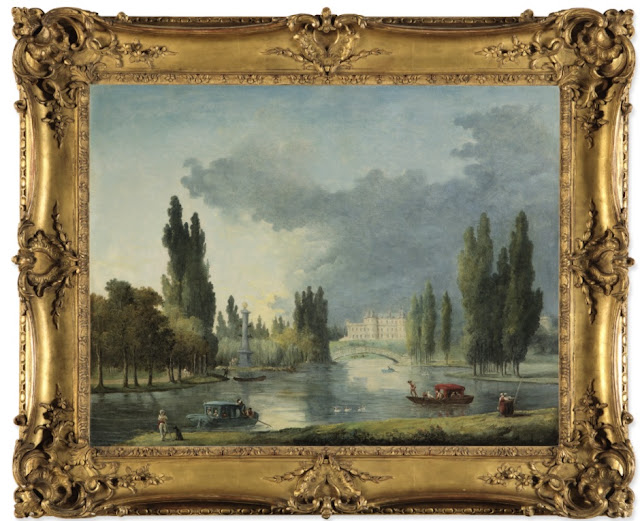Here are two striking oil paintings of Méréville by Hubert Robert which were auctioned by Sotheby's New York in January of last last year. Although they have been previously exhibited and documented, this is the first time that images have been readily accessible on the internet. According to the catalogue notes, the pictures originally hung in Laborde's hôtel in the rue Cerutti and were at one time the property of comte Alexandre de Laborde (1853-1944) the financier's great-grandson. The sale price was $620,000, which was within the estimate.
https://www.sothebys.com/en/buy/auction/2019/master-paintings-evening-sale/hubert-robert-the-lake-and-chateau-at-mereville
Following his appointment as Dessinateur des Jardins du Roi in 1784 Robert enjoyed an established reputation as a designer of landscapes. He worked on a number of concurrent commissions at this time: at Méréville, at Betz and on the Laiterie de la Reine at Rambouillet. He was associated with Laborde's project for the house and gardens at Méréville over a prolonged period, between May 1786 and April 1793. Laborde and Robert moved in the same social circles and were bound together by a unity of outlook. They were both, for example, intimates of Elisabeth Vigée Lebrun; her supper parties also included the financier Boutin, Jacques Deville and the comte d'Angiviller, Director of Royal Buildings, who was Laborde's brother-in-law and Robert's patron. In 1789 Laborde purchased Lebrun's famous portrait of Robert which he displayed as a pendant to Lebrun's Self-portrait with daughter.
Robert's exact contribution to the gardens with which he is associated is not always easy to establish. However, Robert's biographer, Jean de Cayeux discovered in the archives of the duc de Mouchy in the Archives Nationales over fifty documents evoking the collaboration between Robert and Laborde at Méréville. They confirm that Robert was responsible for the realisation of the park, for which Belanger had supplied only the initial ground plan. Twenty six letters and thirteen reports spread over the eight years show the sincere mutual regard in which the two men held each other.
 |
| |
Robert's depictions of Méréville are numerous, and scattered through both public and private collections. As Gabriel Wick notes, they pose a certain problem of interpretation since they include both Robert's working oil sketches used to guide the construction of the park, but also larger scale views intended for display, mostly in Laborde's townhouse, to illustrate the ongoing work and arouse the interest of his guests.
Among Robert's most substantial works for Méréville were six large panels commissioned by Laborde in 1787 to decorate the Salon d'hiver and the Billiard Room on the ground floor of the château. The four paintings made for the salon d'hiver, which depict fanciful Roman ruins, are now in the Art Institute of Chicago. No doubt they were intended to anticipate and compliment the gardens beyond the windows. Today, their positioning is indicated in the partly restored house by modern replicas. The two paintings in the Billiard Room were fanciful views of Méréville itself imagined as an Arcadian paradise.
See: Art Institute of Chicago: https://www.artic.edu/artists/36407/hubert-robert
 |
| Hubert Robert, Château de Méréville Collections of the Domaine de Sceaux Wikimedia Commons |
This second large scale view, which is from a private collection, featured in the 2017 exhibition, "Hubert Robert et la fabrique des jardins", curated by Gabriel Wicks. It is one of the two canvasses that from the Billiard Room at Méréville. In the background is the Temple of Filial Piety and the Petit parc. The picture below, which is also privately owned, was also included in the exhibition. It shows the wooden bridge and Grande Cascade from the vantage point of the grotto; at the bottom left Robert has included himself at work on one of his sketches.
There are various smaller pictures in public collections: The National Museum of Fine Arts in Stockholm has a pair of canvasses, depicting views of the wooden bridge and cascade. They are the same size as the two canvases sold by Sothebys, so maybe they belonged to the same set. See https://www.nationalmuseum.se/en/webtour/hubert-roberts-bildvärld
 |
| Nationalmuseum, Stockholm, NM2794 and NM 2094. Both 65 cm x 81 cm. |
Conseil départemental de l'Essonne, direction des Archives et du Patrimoine mobilier.
 |
| https://www.facebook.com/CDEssonne/ville-et-la-grande-cascade-hub/1503532553158732/ |
This canvas represents one of the principal "scenes" of the garden, clustered around the Small Lake, at the foot of Trajan's Column. The ensemble consisted of the Cascade, the Rock Arch, and the promontory on which sat the rustic cabin.










The breadth of Roberts accomplishments is remarkable but did he understand the the techniques of landscape manipulation as La Notre ?????
ReplyDeleteFair comment. I think Robert was always first and foremost a painter and visionary.
Delete